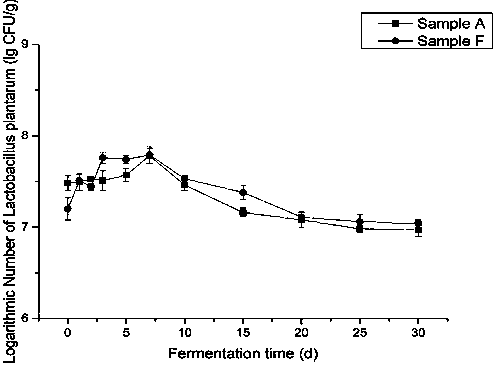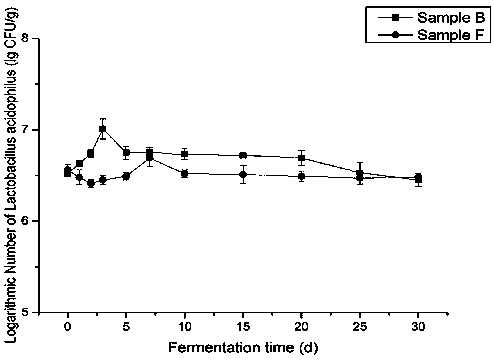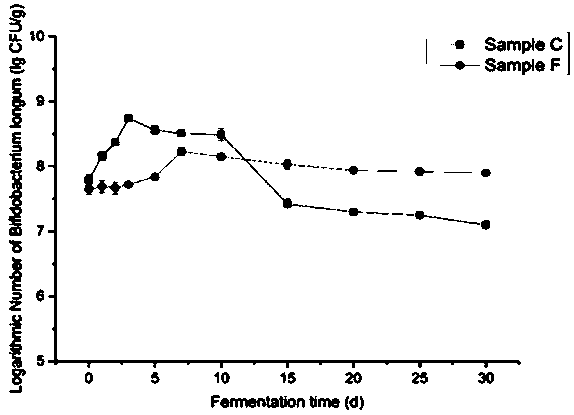Detection method of lactic acid bacteria flora changes in biological feed fermentation process
A technology for biological feed and fermentation process, applied in the field of molecular biology, can solve the problems of few reports of changes in bacterial flora, lack of effective methods for the identification of bacteria with similar growth and colonies, etc., and achieves short detection period, simple operation and repeatability. Good results
- Summary
- Abstract
- Description
- Claims
- Application Information
AI Technical Summary
Problems solved by technology
Method used
Image
Examples
Embodiment 1
[0051] Example 1: Quantitative analysis of changes in the number of lactic acid bacteria flora during the step-by-step fermentation of biological feed
[0052] The raw materials are 80g of corn stalks and 20g of bran, a total of 100g, the water content is 40%, the added aerobic bacteria are Bacillus subtilis and Saccharomyces cerevisiae, and the added lactic acid bacteria are the same amount of Lactobacillus plantarum, Lactobacillus acidophilus, Bifidobacterium longum bacillus, Lactobacillus casei and Lactobacillus rhamnosus, the addition of aerobic bacteria and lactic acid bacteria are all 5% of the raw material. The fermentation method adopted is step-by-step fermentation, that is, aerobic bacteria are added to aerobic fermentation for 12 hours, and then lactic acid bacteria are added, and immediately sealed for anaerobic fermentation. A total of 6 samples were set up, and each sample was replicated 3 times. The DNA of the 0d, 1d, 2d, 3d, 5d, 7d, 10d, 15d, 20d, 25d and 30d s...
Embodiment 2
[0056] Example 2: Quantitative analysis of changes in the number of lactic acid bacteria flora during the simultaneous fermentation of biological feed
[0057] The same conditions as in Example 1 were adopted, but the step-by-step fermentation was changed to synchronous fermentation, that is, aerobic bacteria and anaerobic bacteria were added at the same time and then directly packaged for fermentation.
[0058] For specific results, see Image 6 , 7 , 8, 9 and 10. From the test results, it can be seen that the step-by-step fermentation of aerobic bacteria and anaerobic probiotics is compared with the synchronous fermentation after adding aerobic bacteria and anaerobic probiotics at the same time. From the sample F mixed with five kinds of bacteria, the measured value of simultaneous fermentation The bacterial counts of the five kinds of bacteria are all larger than those measured by the step-by-step fermentation. For example, the number of Lactobacillus plantarum in sample ...
Embodiment 3
[0059] Embodiment 3: molecular biology experiment
[0060] 3.1 Culture of bacteria and extraction of genomic DNA
[0061] Fully mix the lyophilized powder of the standard strain with an appropriate amount of sterile saline, inoculate it in PDA solid medium, and then place it in a constant temperature incubator at 37°C for 48 hours, then pick a single colony with a sterile inoculation loop and inoculate it into MRS In the culture medium, culture anaerobically at 37°C to activate the strain until the OD of the strain 600 The value is 0.8.
[0062] The cultured fresh bacteria of the standard strains were collected, and the bacterial DNA was extracted using the Bacterial Genome Extraction Kit (Shanghai Sangong). For the specific operation steps, see the kit instruction manual.
[0063] 3.2 Design and synthesis of primers
[0064] Primer5.0 primer design software was used to design specific primers for five lactic acid bacteria. The obtained primers are shown in Table 1. The obt...
PUM
| Property | Measurement | Unit |
|---|---|---|
| PCR efficiency | aaaaa | aaaaa |
| correlation coefficient | aaaaa | aaaaa |
Abstract
Description
Claims
Application Information
 Login to View More
Login to View More - R&D
- Intellectual Property
- Life Sciences
- Materials
- Tech Scout
- Unparalleled Data Quality
- Higher Quality Content
- 60% Fewer Hallucinations
Browse by: Latest US Patents, China's latest patents, Technical Efficacy Thesaurus, Application Domain, Technology Topic, Popular Technical Reports.
© 2025 PatSnap. All rights reserved.Legal|Privacy policy|Modern Slavery Act Transparency Statement|Sitemap|About US| Contact US: help@patsnap.com



